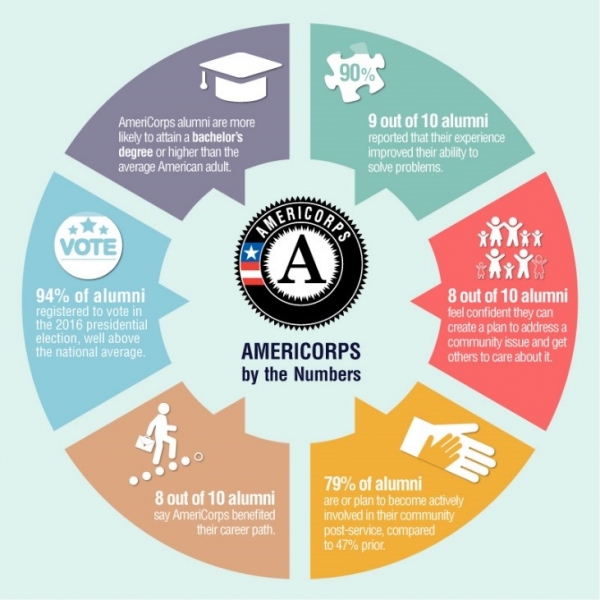Youth who receive special education services under the Individuals with Disabilities Education Act (IDEA 2004) and especially young adults of transition age, should be involved in planning for life after high school as early as possible and no later than age 16. Transition services should stem from the individual youth’s needs and strengths, ensuring that planning takes into account his or her interests, preferences, and desires for the future.
National Service
National service refers to programs like AmeriCorps, Senior Corps, and other programs and initiatives. Participants in these programs address community needs in disaster services, economic opportunity, education, the environment, health, and veterans and military families.
Rates
Since 1994, 1 million individuals have served 1.4 billion hours in AmeriCorps and have earned $3.3 billion of Segal AmeriCorps Education Awards. In 2015 AmeriCorps members served at 21,600 unique sites, managing or mobilizing 2.3 million community volunteers, and leveraging $1 billion worth of resources from other sources. Figure 1 shows the breakdown of 2015 AmeriCorps services.1
FIGURE 1: AMERICORPS BY THE NUMBERS

Benefits for Youth
A growing body of research shows that national service has an effect on more than just communities served, but also on AmeriCorps members. Through surveying 3,772 AmeriCorps alumni, and a secure data match with the National Student Clearinghouse, the AmeriCorps Alumni Outcomes Study2 found that:
- AmeriCorps service is found to have a significant positive effect on civic engagement; respondents were more likely to engage in all community service activities asked about in the survey post-AmeriCorps compared to pre-AmeriCorps. There was also a positive effect seen on sense of community, cultural competency and measures of self-efficacy.
- The study found that AmeriCorps service had significant effects on alumni’s employment and career pathways. For example, AmeriCorps alumni are more likely to attain a bachelor’s degree or higher than the average American adult.
Resources
AmeriCorps
This program engages more than 80,000 Americans in intensive service each year at 21,600 unique sites including nonprofits, schools, public agencies, and community and faith-based groups across the country.
AmeriCorps Alumni Outcomes Study
This study explores how national service experiences successfully encourage national service alumni to stay civically engaged, develop and utilize skills gained through service, and/or pursue service-oriented careers and post-secondary education and employment.
Results from the National Student Clearinghouse Data Match: New Methods for Assessing AmeriCorps Alumni Outcomes
This report executed a data match of a sample of three cohorts of AmeriCorps alumni (who completed their last term of service in 2005, 2010, and 2013) to postsecondary enrollment and graduation records held by the National Student Clearinghouse.
SeniorCorps
This AmeriCorps program connects today’s 55+ with the youth and youth organizations that need them most through mentoring, coaching, or companionship.
Still Serving: Measuring the Eight-Year Impact of AmeriCorps on Alumni (PDF, 56 pages)
This study assesses the outcomes and impacts of national and community service on individuals who serve in AmeriCorps State and National and AmeriCorps National Civilian Community Corps. The objective of the study is to identify the effects of AmeriCorps on members’ civic engagement and volunteering, employment and careers, educational attainment, and life satisfaction.
References
Other Resources on this Topic
Agencies
Announcements
Collaboration Profiles
Feature Articles
Internships
Programs
Publications
Resources
Technical Assistance
Tools & Guides
Websites
Youth Topics
Youth Briefs
Research links early leadership with increased self-efficacy and suggests that leadership can help youth to develop decision making and interpersonal skills that support successes in the workforce and adulthood. In addition, young leaders tend to be more involved in their communities, and have lower dropout rates than their peers. Youth leaders also show considerable benefits for their communities, providing valuable insight into the needs and interests of young people
Statistics reflecting the number of youth suffering from mental health, substance abuse, and co-occurring disorders highlight the necessity for schools, families, support staff, and communities to work together to develop targeted, coordinated, and comprehensive transition plans for young people with a history of mental health needs and/or substance abuse.
Nearly 30,000 youth aged out of foster care in Fiscal Year 2009, which represents nine percent of the young people involved in the foster care system that year. This transition can be challenging for youth, especially youth who have grown up in the child welfare system.
Research has demonstrated that as many as one in five children/youth have a diagnosable mental health disorder. Read about how coordination between public service agencies can improve treatment for these youth.
Civic engagement has the potential to empower young adults, increase their self-determination, and give them the skills and self-confidence they need to enter the workforce. Read about one youth’s experience in AmeriCorps National Civilian Community Corps (NCCC).






